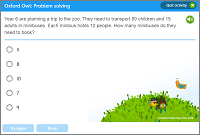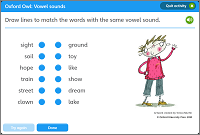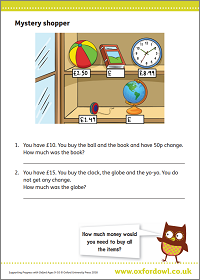Jargon buster: 'Tricky words' to
'word problems'

A | B–C | D–G | H–L | M | N–O | P | Q–R | S | T–Z
A | B | C | D | E | F | G | H | I | J | K | L | M | N | O | P | Q | R | S | T | U | V | W | X | Y | Z
T
Tense
The verb in a sentence shows the tense. It shows when something happens.
Present tense: The present tense shows that something is happening now or is true now.
For example: The bird likes apples and often pecks them to see if they are good.
The present tense is also used to show something is going to happen (or about to happen) in the future.
For example: I start school next year.
(Also see Progressive.)
Past tense: The past tense is used to describe something that has happened. The past tense is normally shown by adding -ed but some verbs change completely.
For example:
The bird pecked the apple.
I went to the cinema.
The past tense is also used to talk about a situation that is imagined or wished for.
For example:
If we left now, we’d be able to watch the match on TV.
I wish I had a dog.
Video: Grammar: verbs and tenses
Tricky words
In some English words, the spelling of the word doesn’t appear to fit with the phonemes that children have been taught so far. These words are taught as whole words rather than as a combination of sounds.
Tricky words include the, go, said, my, he.
They are also sometimes known as 'red words' or 'exception words'.
Two-step problems
A word problem that requires two 'steps' in order to be solved is a two-step problem.
For example: I have £6.50 to spend. If I buy two magazines priced at £1.95 each, how much money will I have left over?
This requires two steps because we need to first add £1.95 and £1.95 to each other, and then take away this total from £6.50. In later years, children will encounter multi-step problems – that is, problems involving more than two steps.
Activity: Maths: Problem solving (Age 10–11)

U
Unit fraction
A unit fraction is a fraction which has 1 as its numerator.
For example: ½ is a unit fraction, because the numerator is 1.
Using and applying mathematics
We use maths in everyday life, drawing upon our maths knowledge and applying it, for example to calculate how much wallpaper we need to buy when redecorating. This is known as 'using and applying' our maths skills in everyday life.
V
Verb
A verb often names an action but it can also describe feelings or states.
For example: The bird pecks the apple and eats it. The bird is happy.
The most basic form of a verb is called the infinitive. Tenses are formed by inflecting the infinitive.
Regular verb: Regular verbs change their endings in predictable ways. In the present tense, most verbs add an -s in their third person form.
For example: I run, she runs.
The suffix -ed is added to form the past tense.
For example: I shout, we shouted.
-ing is added to form participles.
For example: I listen, she is listening, we were listening, they will be listening.
Irregular verb: Irregular verbs have varied forms, especially in the past tense.
For example: We swim, we swam, we have swum; you take, you took, you have taken.
Video: Grammar: verbs and tenses
Vowel
Vowels are sounds represented by the following letters: 'a', 'e', 'i', 'o', 'u' and sometimes 'y'. All other sounds are called consonants and are represented by the other letters in the alphabet, which are called consonant letters.
Activity: Vowel sounds (Age 4–5)

W
Word family
Word families are words related to each other by spelling, grammar and/or meaning.
For example: noise, noisy, noiseless.
Word problems
A problem written in everyday language that requires maths to find the answer. Children will work with word problems frequently.
For example: Oranges cost 69p a kilo. I pay for a kilo of oranges with a £1 coin. How much change will I get?
Activity: Problem solving (Age 9–10)

A | B–C | D–G | H–L | M | N–O | P | Q–R | S | T–Z
A | B | C | D | E | F | G | H | I | J | K | L | M | N | O | P | Q | R | S | T | U | V | W | X | Y | Z